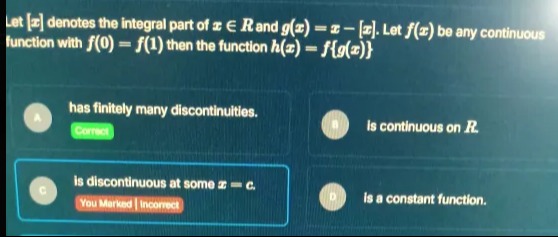Question
Question: Let $[x]$ denotes the integral part of $x \in R$ and $g(x) = x - [x]$. Let $f(x)$ be any continuous ...
Let [x] denotes the integral part of x∈R and g(x)=x−[x]. Let f(x) be any continuous function with f(0)=f(1) then the function h(x)=f{g(x)}

A
has finitely many discontinuities.
B
is continuous on R.
C
is discontinuous at some x=c.
D
is a constant function.
Answer
B
Explanation
Solution
The function g(x) = x – [x] (i.e. the fractional part of x) is discontinuous at integers because it jumps from 1 (as x→n⁻) to 0 (as x→n⁺). However, since f is continuous and f(0) = f(1), the composition h(x) = f(g(x)) “patches” these jumps: at any integer n, the left-hand limit becomes f(1) and the right-hand limit becomes f(0), which are equal. Therefore, h(x) is continuous on ℝ.
